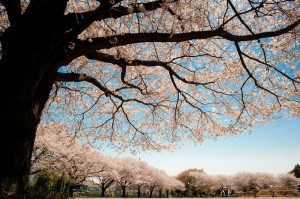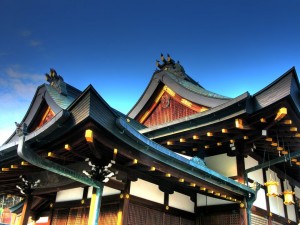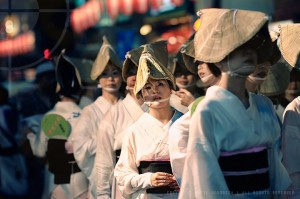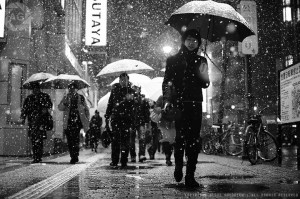14 hours is a long stretch by most means, and it seems more so in a cramped bucket seat in the middle of aisle 24 of a jumbo jet flying over the Pacific, through LAX and heading for NRT. The impending vacation in Japan is attractive, but of course you never looked forward to the flight – you want to be there, but the getting there isn’t much part of the fun. You’ve never been one for submitting yourself to extended periods of discomfort, and while not torture by definition there are many more places you’d like to be than the aeronautical limbo that is unavoidable flying halfway around the world, with the leg cramps and snoring and babies keeping you awake just enough to be continuously conscious of how unconscious you wish you were…
but even so, the requisite transit time between East and West is both necessary and, in the scheme of things, a small price rendered over a relatively short period in comparison to the experience in whole. To have the chance to experience Japan’s distinct culture, you decided that the short and passing discomforts of the trip to your destination are just a part of the bigger adventure that awaits there. So your plane lands at Narita and the aisle lights come on. You and hundreds of others get up and stretch, shaking off blankets and crumbs and whatever else has accumulated over the hours, taking your bags and shuffling down the length of the plane to your first breath of non-cabin air. But the herd doesn’t break,
and in your plane-drained state being caught in that flow is enough to convince you that it is headed in the right direction toward baggage claim just because you don’t feel like thinking otherwise, but as an extra reassurance you hear and see a smattering of languages not least of which is your mother tongue, urging you on to get your stuff. Narita is a strangely vibrant airport. It is clean and streamlined, guiding those stopping by with its stylized but efficient architecture, not so much taking you where you need to go but rather holding your hand and leading you along. Of course, like most friends, it will lead you astray from time to time, suggesting in a veiled tone that you should stop in one or another place against your better, financially-minded judgment, and the friendly “Welcome!” signs staring you down along the way surely help the airport’s friendly nudge to, “just drop in for a look.”
It is a potentially dangerous path, your wallet’s contents not exactly secure, but there are worse thing than being enticed to spend more than you planned on designer clothes and tax-free alcohol at the start of vacation. Through the gauntlet you go, dragging your things somewhat clumsily through the halls (but definitely not in any sort of disorientation like that other guy over there) headed for immigration, where trouble undoubtedly looms, but through which you pass very quickly, surprisingly so, hardly worth mentioning in fact. Whew. Past the gates, marking your entrance back into somewhere, you end up at the turnstile of travel, where you find your luggage, intact, swirling around with the others. You sigh upon heaving your belongings out of the pool, familiar stickers and scrapes relieving you of some of the worry of traveling so far (though you didn’t really expect trouble – it is your lucky suitcase after all). Even with the crowds as large as they are, things here rarely feel truly congested: Narita is an international hub that successfully directs individuals on to their intended destinations. You fly in, show your papers, spot your things, move through the motions, bam-bam-bam one thing after another on the traveler’s checklist is handily dispatched.
Things move maybe a little bit faster than what you are accustomed to, and things are maybe more crowded than you prefer, but there is a smoothness underlying it all that makes the pace alright, maybe even a little exhilarating. Travel is inherently stressful, but here where nothing seems to stand exactly still and is always moving at least a little bit forward, there is a giddiness in that stress suggesting that there are fun, maybe even awesome things awaiting you and that there is not a moment to spare. Within 90 minutes of landing, with all possessions, all visas, and now, after spending only so long deciphering the electronic and not-too-confusing ticket dispenser, all necessary train tickets in hand, you move on towards the station, to make your way towards Tokyo. Your reserved seat ticket, what you bought in case the crowds you came in with got the best of you, indeed served to alleviate some worry when the mass sure enough swelled to greater proportions as it lunged for the doors of the train on opening. The seconds-long window you had to navigate the people around you while the doors remained open certainly added some unwanted excitement to boarding the train.
An adage about Rome or Romans briefly flickers into your mind as you don’t so much as actively get on but rather passively submit to the push into the train, still comfortable in the fact that though the rush is mildly alarming, your ticket will get you out of it soon enough and to your seat – no worries. Once on board, a minor sense of accomplishment for besting the human obstacle coarse keeps a smile lightly painted across your face as you consider how well things have gone so far. The specter of stress is on you, but only as the result of worry that is intrinsic to traveling. Despite having convinced yourself that you’ll lose something, you haven’t yet, and the lines keep on moving and so you do too, ever closer to your resting point, for tonight anyway. That certainty of movement, unlike what you’ve experienced elsewhere in your travels, is what keeps you positive; tired, sure, but nevertheless in high spirits despite the thousands of miles you’ve come. A cool drink, a reclining chair anywhere but on a plane, and an easy train ride to your hotel should begin the process of depressurization, and that is precisely what you face as you approach your seat. Bags up; sit down; beckon to the stewardess; wallet out; tea in hand, jingle of change and you recline.
You begin to relax and the lights outside of your window fly past, creating an ambient landscape to accompany the lull of the train running smoothly over the tracks. Further off in the distance you see the physical shape of the city begin to take form, and you wonder what, in that giant mass of blinking color and sky-scraping obelisks, there might be waiting for you. Surely, a late dinner to rid yourself of the stomach-rumblings of one fed on pretzels and microwave meals for the past 24 hours is soon to come, but even that, in this country so Westernized but not at all western, has you wondering exactly what the results will be. Sure, you’ve just sat on a plane longer than you care to recall (and are again sitting even now!), and have traveled halfway around the world to a foreign country with a very foreign language, but as you are riding a train headed into the heart of Tokyo, and then to who knows where, all you can think of are the possibilities that await you.
By Matthew Ketchum
My Japan
My Japan is a photography exhibition operating out of Tokyo. We were started soon after the 2011 tsunami, when our director sought out photographs addressing the question, “What does Japan mean to you?” We have since received over a thousand of photographs from amateur and professional photographers alike, and we have selected a number of those to put on display at our exhibition at Nirvana in Tokyo Midtown and in our new photography book. The money we raise from the prints and books we sell is, after cost, given to the Japan Emergency Network (JEN) NGO still working in the Tohoku reconstruction effort. Our goal is of course to raise money in order to help those who need it most after the tragic events of March 2011, but we also wish to see this country make gains on its own. Our pictures are necessarily of a subjective nature, with each person having a different experience with this country as the next person. Through the photography we receive and exhibit, we wish to create a more comprehensive, but by no means definitive, image of this country that inspires so many, both within and without its borders. By doing this, we hope to call attention to the many wonderful aspects of Japan in order to attract interest, be it cultural, educational, business, or anything in between. By showing the myriad personal perspectives of what Japan means to many different people, we hope to highlight all of the things that Japan can be, and through that help this country overcome the difficulties that still face it and to become stronger than it was before.


































































